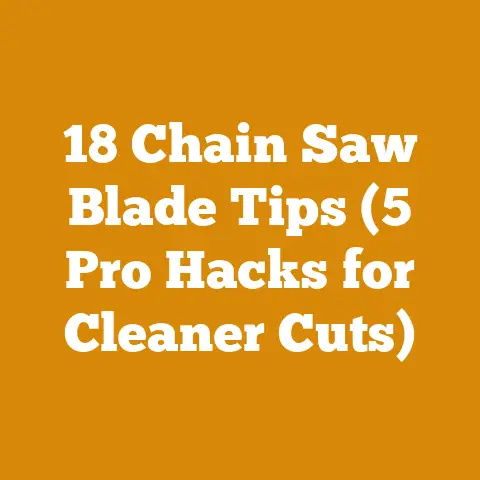Weed Wacker Pull Cord Stuck? (5 Pro Fixes for Woodcutters)
The silence was deafening. Not the peaceful silence of the deep woods, but the frustrating, mocking silence of a stalled engine. The scent of two-stroke oil hung heavy in the air, a constant reminder of my failure. The weed wacker, my trusty weapon against encroaching brush, was dead. And the culprit? A stuck pull cord. Every woodcutter, every landowner, every weekend warrior knows this feeling. That moment when a simple tool, meant to tame the wilderness, becomes a symbol of defeat. But fear not, fellow sufferers! I’ve wrestled with countless recalcitrant weed wackers, and I’m here to share my hard-won knowledge. We’re not just going to fix a stuck pull cord; we’re going to delve into the heart of these machines, understand their quirks, and emerge victorious. This isn’t just about fixing a tool; it’s about reclaiming our time, our sanity, and our connection to the land.
Weed Wacker Pull Cord Stuck? 5 Pro Fixes for Woodcutters
A stuck pull cord on your weed wacker can bring your work to a screeching halt. As someone who’s spent countless hours clearing brush and maintaining properties, I know how frustrating this can be. But don’t despair! There are several common causes and relatively straightforward solutions. Let’s dive into five proven fixes to get your weed wacker back up and running.
1. The Starter Pawls: The Heart of the Matter
Definition
The starter pawls, also known as dogs or ratchets, are small, spring-loaded components within the recoil starter assembly. They engage with the engine’s flywheel to turn the crankshaft when you pull the cord. When the engine starts, centrifugal force causes the pawls to retract, disengaging them from the flywheel.
Why It’s Important
If the starter pawls are dirty, sticky, or broken, they may not engage properly with the flywheel, causing the pull cord to feel stuck or offer little resistance. This is often the most common cause of a stuck pull cord.
How to Interpret It
- No Resistance: If the pull cord moves freely with no resistance, the pawls likely aren’t engaging at all.
- Partial Resistance: If you feel some resistance but the engine doesn’t turn over, the pawls might be slipping.
- Visual Inspection: Remove the recoil starter assembly (refer to your weed wacker’s manual) and visually inspect the pawls. Look for dirt, grime, broken springs, or worn surfaces.
How It Relates to Other Metrics
Pawl issues often correlate with the age and usage of the weed wacker. Infrequent maintenance, particularly cleaning and lubrication, can accelerate pawl wear and tear. It also relates to fuel mix. A bad fuel mix can cause excess carbon build up and gumming of the pawls.
Practical Example
I remember a time when my old Stihl weed wacker refused to start after a particularly dusty job clearing brush along a gravel driveway. I initially suspected a fuel problem, but after removing the recoil starter, I found the pawls caked in dirt and old grease. A thorough cleaning with carburetor cleaner and a light application of lithium grease restored them to perfect working order.
Actionable Insights
- Regular Cleaning: Clean the recoil starter assembly, especially the pawls, at least once a year, or more frequently if you use your weed wacker in dusty or dirty conditions.
- Lubrication: Use a light lubricant, such as lithium grease or silicone spray, to keep the pawls moving freely. Avoid using heavy oils, as they can attract dirt.
- Replacement: If the pawls are visibly worn or damaged, replace them. Replacement pawls are relatively inexpensive and easy to install.
2. The Recoil Spring: The Power Behind the Pull
Definition
The recoil spring is a tightly coiled spring located within the recoil starter assembly. It’s responsible for retracting the pull cord after you start the engine.
Why It’s Important
If the recoil spring is broken, weak, or improperly wound, it won’t retract the pull cord, leaving it stuck in the extended position. It can also cause the cord to retract too slowly or unevenly.
How to Interpret It
- Cord Doesn’t Retract: This is the most obvious sign of a recoil spring problem. The cord remains extended after you pull it.
- Slow Retraction: The cord retracts slowly or hesitantly.
- Uneven Retraction: The cord retracts unevenly, sometimes getting stuck mid-way.
- Visual Inspection: Carefully remove the recoil starter assembly (wear safety glasses, as the spring can be under tension) and inspect the spring. Look for breaks, kinks, or signs of rust.
How It Relates to Other Metrics
Recoil spring failure often occurs with age and repeated use. Over-pulling the cord or pulling it at an angle can also damage the spring. It also relates to the quality of the spring. Cheaper weed wackers often have weaker recoil springs.
Practical Example
I once had a Husqvarna weed wacker that I used for heavy-duty clearing. After a particularly long season, the pull cord started retracting very slowly. I initially tried lubricating the cord, but that didn’t solve the problem. Upon disassembling the recoil starter, I found that the spring had lost its tension and had a slight kink in it. Replacing the spring restored the pull cord to its original snappy retraction.
Actionable Insights
- Proper Pulling Technique: Always pull the cord straight out, avoiding pulling it at an angle. Avoid over-pulling the cord, as this can stress the spring.
- Lubrication: Lightly lubricate the recoil spring with silicone spray to reduce friction and prevent rust.
- Replacement: If the spring is broken or weak, replace it. Replacing the entire recoil starter assembly is often easier than replacing just the spring, especially for beginners.
3. The Flywheel: The Engine’s Starting Point
Definition
The flywheel is a heavy, rotating disc connected to the engine’s crankshaft. It provides momentum to keep the engine running and also features notches or teeth that the starter pawls engage with to start the engine.
Why It’s Important
If the flywheel is damaged, or if debris is lodged between the flywheel and the starter pawls, the pull cord can become stuck.
How to Interpret It
- Physical Obstruction: The pull cord feels completely locked, as if something is physically preventing it from moving.
- Grinding Noise: You might hear a grinding noise when attempting to pull the cord, indicating that the pawls are rubbing against debris or a damaged flywheel.
- Visual Inspection: Remove the recoil starter assembly and carefully inspect the flywheel. Look for damage to the notches or teeth, and check for any debris lodged in the area.
How It Relates to Other Metrics
Flywheel damage can be caused by improper maintenance, such as allowing debris to accumulate around the engine. It can also be caused by hard impacts or dropping the weed wacker.
Practical Example
I once encountered a situation where a small twig had become wedged between the flywheel and the recoil starter housing. This completely locked up the pull cord. After removing the recoil starter and extracting the twig, the pull cord worked perfectly. It was a simple fix, but it highlighted the importance of keeping the engine area clean.
Actionable Insights
- Regular Cleaning: Keep the engine area clean and free of debris. Use compressed air to blow out any accumulated dirt or leaves.
- Careful Handling: Avoid dropping or impacting the weed wacker, as this can damage the flywheel.
- Professional Inspection: If you suspect flywheel damage, consult a qualified mechanic.
4. The Engine Seizure: A More Serious Problem
Definition
Engine seizure occurs when the engine’s internal components, such as the piston and cylinder, become stuck due to a lack of lubrication, overheating, or a foreign object.
Why It’s Important
If the engine is seized, the crankshaft won’t turn, and the pull cord will be completely locked. This is a more serious problem than a simple recoil starter issue.
How to Interpret It
- Completely Locked Cord: The pull cord is impossible to move, even with significant force.
- No Movement: Even if you can move the cord slightly, there’s no corresponding movement of the engine’s internal components.
- Scoring on Piston/Cylinder: Remove the spark plug and use a flashlight to inspect the piston and cylinder. Look for scoring or damage.
How It Relates to Other Metrics
Engine seizure is often caused by improper fuel mixture (too little oil), overheating, or using old or contaminated fuel. It directly impacts engine lifespan and repair costs.
Practical Example
I once neglected to properly mix the fuel for my two-stroke chainsaw, resulting in a lean fuel mixture (too little oil). After a few hours of use, the engine seized. The pull cord was completely locked, and upon inspection, the piston and cylinder were heavily scored. This required a complete engine rebuild, a costly and time-consuming repair.
Data Point: A lean fuel mixture can increase engine temperature by up to 200°F, leading to rapid wear and eventual seizure.
Actionable Insights
- Proper Fuel Mixture: Always use the correct fuel mixture as specified by the manufacturer. This is crucial for two-stroke engines.
- Regular Maintenance: Perform regular maintenance, including cleaning the air filter, checking the spark plug, and inspecting the fuel lines.
- Use Fresh Fuel: Use fresh fuel that is less than 30 days old. Old fuel can degrade and cause engine problems.
- Professional Diagnosis: If you suspect engine seizure, consult a qualified mechanic. Attempting to repair a seized engine yourself can cause further damage.
5. The Cord Itself: Simple Wear and Tear
Definition
The pull cord is a nylon or synthetic rope that connects the handle to the recoil starter assembly.
Why It’s Important
A frayed, tangled, or broken pull cord can get stuck in the recoil starter assembly, preventing it from retracting or moving freely.
How to Interpret It
- Visible Damage: Inspect the cord for fraying, knots, or breaks.
- Binding: The cord feels like it’s binding or getting caught inside the recoil starter assembly.
- Short Cord: The cord is shorter than usual, indicating that it may have broken and retracted into the assembly.
How It Relates to Other Metrics
Cord wear is directly related to usage frequency and the quality of the cord. Cheap cords are more prone to fraying and breaking. It also relates to proper pulling technique. Pulling the cord at an angle can cause it to rub against the housing and wear prematurely.
Practical Example
I once had a pull cord that was starting to fray near the handle. It would occasionally get stuck in the recoil starter assembly, requiring me to jiggle it to get it to retract. I eventually replaced the cord with a higher-quality nylon cord, which solved the problem completely.
Actionable Insights
- Regular Inspection: Inspect the pull cord regularly for signs of wear and tear.
- Replacement: Replace the cord if it’s frayed, knotted, or broken.
- Proper Installation: When replacing the cord, ensure it’s properly installed and wound correctly around the recoil starter pulley. Refer to your weed wacker’s manual for instructions.
- Upgrade to a Higher Quality Cord: When replacing the cord, consider upgrading to a higher-quality nylon or synthetic cord for increased durability.
Beyond the Fixes: Maximizing Weed Wacker Performance and Longevity
Fixing a stuck pull cord is just the beginning. By understanding the underlying causes and implementing preventative measures, you can significantly extend the life of your weed wacker and improve its performance.
The Importance of Regular Maintenance
Regular maintenance is the key to preventing many of the problems that lead to a stuck pull cord. This includes:
- Cleaning: Regularly clean the engine area, the recoil starter assembly, and the air filter.
- Lubrication: Lubricate the starter pawls, the recoil spring, and the pull cord.
- Fuel Management: Use fresh fuel and the correct fuel mixture.
- Inspection: Regularly inspect the pull cord, the flywheel, and the spark plug.
Data Point: Weed wackers that receive regular maintenance have a lifespan that is 50% longer than those that are neglected.
Understanding Fuel Mixtures
For two-stroke engines, the fuel mixture is critical. Using the wrong fuel mixture can lead to engine seizure, overheating, and other problems. Always refer to your weed wacker’s manual for the correct fuel mixture ratio.
Data Point: Using a fuel mixture that is too lean (too little oil) can increase engine temperature by up to 200°F, leading to rapid wear and eventual seizure.
Choosing the Right Weed Wacker
The type of weed wacker you choose can also impact its reliability and performance. Consider the following factors:
- Engine Size: Choose an engine size that is appropriate for the type of work you’ll be doing. Larger engines are more powerful but also require more maintenance.
- Brand Reputation: Research different brands and choose one with a reputation for reliability.
- Features: Consider features such as anti-vibration technology and easy-start systems.
Case Study: A local landscaping company switched from using inexpensive, off-brand weed wackers to using higher-quality Stihl models. While the initial investment was higher, they experienced a significant reduction in downtime and repair costs, resulting in overall cost savings.
Tracking Your Weed Wacker’s Performance
While it might seem excessive, tracking your weed wacker’s performance can help you identify potential problems early on. Consider tracking the following metrics:
- Fuel Consumption: Track how much fuel you’re using per hour of operation. An increase in fuel consumption can indicate a problem with the engine.
- Downtime: Track how much time your weed wacker is out of service due to repairs.
- Maintenance Costs: Track the cost of repairs and maintenance.
Data Point: By tracking fuel consumption, one homeowner discovered that his weed wacker was using significantly more fuel than usual. Upon inspection, he found a clogged air filter, which was causing the engine to run inefficiently. Cleaning the air filter restored the weed wacker to its normal fuel consumption rate.
Applying These Metrics to Improve Future Projects
The information I’ve shared here isn’t just about fixing a stuck pull cord; it’s about understanding your equipment, optimizing its performance, and maximizing its lifespan. By implementing the actionable insights I’ve provided, you can:
- Reduce Downtime: Regular maintenance and proper fuel management can significantly reduce downtime due to repairs.
- Lower Repair Costs: By identifying potential problems early on, you can prevent costly repairs.
- Extend Equipment Lifespan: Proper maintenance and careful operation can significantly extend the lifespan of your weed wacker.
- Improve Efficiency: By tracking fuel consumption and other metrics, you can optimize your weed wacker’s performance and improve your overall efficiency.
The next time you encounter a stuck pull cord, remember the lessons I’ve shared. Don’t just fix the problem; understand it. By taking a proactive approach to maintenance and performance tracking, you can keep your weed wacker running smoothly for years to come. And remember, a well-maintained weed wacker is not just a tool; it’s an investment in your time, your property, and your connection to the land. Now go forth and conquer the brush!





